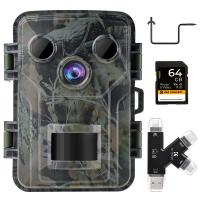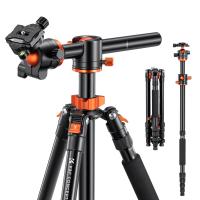What Microscope Can See Cells ?
A light microscope is the most common type of microscope used to see cells. It uses visible light to illuminate the sample and magnifies the image through a series of lenses. With a light microscope, cells can be seen at a magnification of up to 1000 times their actual size. However, to see smaller structures within cells, such as organelles, an electron microscope is needed. Electron microscopes use a beam of electrons instead of light to magnify the sample, allowing for much higher magnification and resolution.
1、 Light Microscopy
What microscope can see cells? The answer is Light Microscopy. Light microscopy is a technique that uses visible light to illuminate a sample and magnify it. It is the most commonly used type of microscopy in biology and can be used to observe living cells and tissues.
With light microscopy, cells can be observed in great detail, including their shape, size, and internal structures. This technique has been used for over 300 years and has undergone many advancements, including the development of fluorescent microscopy, confocal microscopy, and super-resolution microscopy.
Fluorescent microscopy uses fluorescent dyes to label specific structures within cells, allowing for more detailed observations. Confocal microscopy uses a laser to scan a sample and create a 3D image, providing even greater detail. Super-resolution microscopy uses specialized techniques to overcome the diffraction limit of light, allowing for even higher resolution images.
Despite these advancements, light microscopy still has its limitations. It cannot observe structures smaller than the wavelength of visible light, such as individual molecules. For this reason, electron microscopy is often used in conjunction with light microscopy to provide a more complete picture of cellular structures.
In conclusion, light microscopy is the most commonly used technique for observing cells and tissues. It has undergone many advancements over the years, allowing for more detailed observations. However, it still has its limitations and is often used in conjunction with other techniques to provide a more complete picture of cellular structures.

2、 Fluorescence Microscopy
Fluorescence microscopy is a type of microscope that can see cells. It is a powerful tool used in biological research to visualize and study the structure and function of cells. Fluorescence microscopy works by using fluorescent dyes or proteins that are attached to specific molecules within the cell. When these molecules are excited by a specific wavelength of light, they emit a fluorescent signal that can be detected by the microscope.
Fluorescence microscopy has revolutionized the way we study cells. It allows us to visualize specific molecules within cells, such as proteins, DNA, and RNA, and to track their movements and interactions in real-time. This has led to many important discoveries in cell biology, including the identification of new cellular structures and the mechanisms underlying cellular processes such as cell division and signaling.
In recent years, advances in fluorescence microscopy have further expanded its capabilities. Super-resolution microscopy techniques, such as stimulated emission depletion (STED) microscopy and structured illumination microscopy (SIM), have allowed researchers to visualize structures within cells at a resolution beyond the diffraction limit of light. This has opened up new avenues for studying the nanoscale organization of cells and the interactions between molecules within them.
Overall, fluorescence microscopy is a powerful tool for studying cells and has contributed greatly to our understanding of the complex processes that occur within them. With continued advances in technology, it is likely that fluorescence microscopy will continue to play a key role in biological research for years to come.

3、 Confocal Microscopy
Confocal microscopy is a type of microscope that can see cells. It is a powerful imaging technique that allows researchers to obtain high-resolution images of cells and tissues. Confocal microscopy uses a laser to scan a sample and create a three-dimensional image of the sample. This technique is particularly useful for studying the structure and function of cells, as well as for visualizing the distribution of molecules within cells.
One of the latest developments in confocal microscopy is the use of super-resolution techniques. These techniques allow researchers to obtain even higher resolution images of cells and tissues, which can reveal details that were previously invisible. For example, super-resolution microscopy has been used to study the structure of synapses, the tiny gaps between nerve cells where chemical signals are transmitted.
Another recent development in confocal microscopy is the use of live-cell imaging. This technique allows researchers to observe cells in real-time, which can provide insights into the dynamic processes that occur within cells. For example, live-cell imaging has been used to study the movement of proteins within cells, as well as the process of cell division.
Overall, confocal microscopy is a powerful tool for studying cells and tissues. With the latest developments in super-resolution and live-cell imaging, this technique is likely to continue to play an important role in advancing our understanding of the structure and function of cells.

4、 Transmission Electron Microscopy
Transmission Electron Microscopy (TEM) is a type of microscope that can see cells. It is a powerful tool that uses a beam of electrons to create high-resolution images of biological samples. TEM has been used extensively in the field of cell biology to study the structure and function of cells.
TEM has the ability to visualize the internal structures of cells, including organelles such as mitochondria, ribosomes, and the endoplasmic reticulum. It can also reveal the ultrastructure of cells, such as the arrangement of proteins and lipids in the cell membrane.
In recent years, TEM has been used to study the interactions between cells and their environment. For example, researchers have used TEM to study the structure of viruses and how they interact with host cells. TEM has also been used to study the structure of bacterial biofilms, which are communities of bacteria that form on surfaces.
One of the latest developments in TEM is the use of cryo-electron microscopy (cryo-EM). Cryo-EM allows samples to be imaged at very low temperatures, which helps to preserve their structure. This technique has been used to study the structure of proteins and other biomolecules at high resolution.
In conclusion, TEM is a powerful tool that can be used to study the structure and function of cells. It has been used extensively in cell biology and continues to be an important technique for understanding the complex world of cells and their interactions with their environment.







































